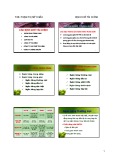
1
Ch ng 4ươ
Qu n tr Tài s n – Ngu n ả ị ả ồ
v n c a Ngân hàng (ALM)ố ủ
Required Readings: Peter S.Rose, Ch ng 6, 7, 8ươ

2
N i dung ch ngộ ươ
M c đích c a qu n tr ALMụ ủ ả ị
R i ro lãi su t tác đ ng đ n kinh doanh ngân ủ ấ ộ ế
hàng
R i ro lãi su t: GAP và s nh y c m thu ủ ấ ự ạ ả
nh pậ
ng d ng Duration trong qu n tr RRLSỨ ụ ả ị

3
Asset-Liability Management
M c đích c a Qu n tr ALM?ụ ủ ả ị

4
Lãi su t hoàn v n ấ ố
Yield to Maturity (YTM)
∑
=
+
=
n
1t
t
t
YTM) (1
CF
PriceMarket

5
Bank Discount Rate (DR)
Maturity toDays #
360
*
FV
Price Purchase- FV
DR
=
Trong đó: FV equals Face Value


























